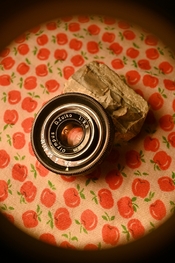In Post #28, IC mentions the unique design of the Rokker 30 mm CE lens with “exaggerated flange-focal distance.”
That, of course, would make positioning the lens at the appropriate distance to the negative much easier than with a standard short-focal-length enlarging lens.
This idea was apparently also used in the design of the Computar 30 mm f/2.8 lens intended as a wide-angle enlarging lens for the 35 mm format. At 30 mm focal length, it would also certainly work with smaller negatives, provided that sufficient projection distance was available.
It apparently was also equipped with an integral radially graduated neutral-density filter coated onto one of the lens elements.
Time-Life Photography Year 1979 Edition, page 160
“Two unique lenses, adaptable to a number of enlargers, came from Computar. A wide-angle 30mm f/2.8 lens for 35mm gives large magnifications without requiring that the enlarger head be raised a great distance from the easel: it can make a 20 by 30 inch print on an average 35mm enlarger. The lens is designed to be placed the same distance from the film as normal lenses, allowing its use with condenser or diffusion enlargers. The falloff of light at the edges, common with wide-angle lenses, is reduced by coating one of the elements to even out the illumination.
The other Computar lens, the 55mm, is exceptionally fast—f/1.9—for sharp, large prints made from negatives that would otherwise require long exposure times. It uses an unusual solution to a problem that affects large-aperture lenses—the difficulty of providing a “flat field” of maximum sharpness from edge to edge at all magnification settings. Computar made one of the elements inside the lens “float” so that it could shift slightly backward or forward with a dial. This adjustment is needed only when the lens is used wide open. After the desired magnification is set and the lens is focused for sharpness at the center of the image, the floating element is shifted until the edges of the image are as sharp as the center.”
http://125px.com/docs/manuals/darkroom/computar/computar_lenses.pdf





